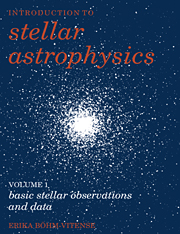Book contents
- Frontmatter
- Contents
- Preface
- 1 Positions of stars
- 2 Proper motions of stars
- 3 Distances of nearby stars
- 4 The brightnesses of the stars
- 5 Color magnitude diagrams
- 6 The luminosities of the stars
- 7 Angular radii of stars
- 8 Effective temperatures of stars
- 9 Masses and radii of stars
- 10 Spectral classification
- 11 Understanding stellar spectra
- 12 Population II stars
- 13 Stellar rotation
- 14 Stellar magnetic fields
- 15 Stars with peculiar spectra
- 16 Pulsating stars
- 17 Explosive stars
- 18 Our sun
- 19 Interstellar absorption
- Appendixes
- References
- Index
19 - Interstellar absorption
Published online by Cambridge University Press: 04 August 2010
- Frontmatter
- Contents
- Preface
- 1 Positions of stars
- 2 Proper motions of stars
- 3 Distances of nearby stars
- 4 The brightnesses of the stars
- 5 Color magnitude diagrams
- 6 The luminosities of the stars
- 7 Angular radii of stars
- 8 Effective temperatures of stars
- 9 Masses and radii of stars
- 10 Spectral classification
- 11 Understanding stellar spectra
- 12 Population II stars
- 13 Stellar rotation
- 14 Stellar magnetic fields
- 15 Stars with peculiar spectra
- 16 Pulsating stars
- 17 Explosive stars
- 18 Our sun
- 19 Interstellar absorption
- Appendixes
- References
- Index
Summary
Introduction
Even though this volume is dedicated only to stellar observations and the theory of stellar structure, we have to talk a little about the interstellar material, which means the material which is between the stars, because the light of the stars, especially of those which are very far away, has to pass through this interstellar material before it reaches us. Just as in the Earth's atmosphere, the star light is influenced by interstellar absorption, also called interstellar extinction. We cannot observe all the light which is emitted from the star because the interstellar gas and the interstellar grains, called dust, have absorbed part of the light. Just as for the Earth's atmosphere, we have to correct for interstellar absorption. For the Earth's atmosphere we can determine the extinction if we observe the star at different zenith distances, which means for different path lengths, through the atmosphere. For interstellar extinction we cannot do this since the path length through the interstellar medium is always the same. We have to find other ways to determine the influence of the interstellar extinction.
Basically there are two components of interstellar extinction: the absorption by the grains and the absorption by the gas. These components are usually, but not necessarily, associated. In the following paragraphs, we will discuss both components and see how we can find out about interstellar absorption.
- Type
- Chapter
- Information
- Introduction to Stellar Astrophysics , pp. 213 - 230Publisher: Cambridge University PressPrint publication year: 1989

